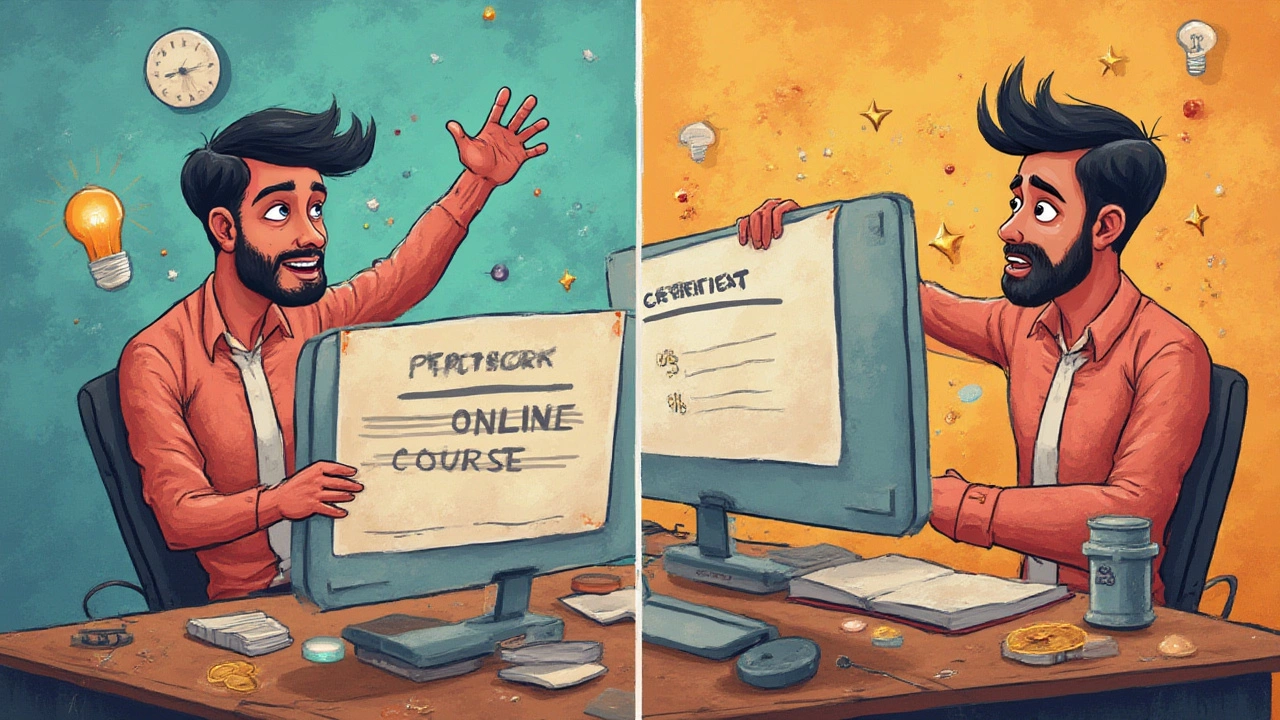
Staring at the words “Enroll for Free!” feels like stumbling onto buried treasure on the web. You click, thinking you’ve struck gold—a course from a fancy platform promising lifetime skills, all without spending a rupee (or dollar). But as you work your way through registration, lectures, quizzes, and maybe even ace your assignments, you hit a brick wall: the platform dangles a certificate for a price. Or suddenly, lessons and materials you need are locked behind a paywall. So, are free online courses really free, or is there always a catch? Let's pull back the curtain on what’s actually going on.
The Truth About "Free": What You Actually Get
The word “free” feels magical but it comes with fine print. When it comes to online courses, the core lesson content is often free: you can watch videos, view slides, maybe even join discussion forums. But try downloading materials, skipping ahead, or accessing premium quizzes, and suddenly paywalls start popping up. For instance, platforms like Coursera or edX give you access to course videos for free but keep assignments and official certificates gated behind a payment. Sometimes, even those “free” features disappear after a trial period. You could spend two months learning Python on a well-known platform, only to discover you need to pay for assignments to unlock the full course or get that coveted certificate.
Let’s take a quick look at the real breakdown. Here’s a table showing popular course platforms and what their “free” tier actually offers:
| Platform | Lessons | Quizzes | Assignments | Certificate |
|---|---|---|---|---|
| Coursera | Free | Some | Paid | Paid |
| edX | Free | Some | Paid | Paid |
| Udemy | Paid (sales often) | Paid | Paid | Paid |
| FutureLearn | Free (limited time) | Free (limited) | Paid | Paid |
| Khan Academy | Free | Free | Free | Not Provided |
| Alison | Free | Free | Free | Paid |
The big surprise: the vast majority of online learners don’t finish free courses. According to Class Central’s 2023 report, less than 10% of students ever complete a MOOC (Massive Open Online Course). When courses are free, people are less motivated to wrap them up. That means putting money down sometimes isn’t just a money grab—sometimes it gets you to the finish line.
Hidden Costs: When Free Turns Fee
The real catch comes after you’re invested. It starts innocently—watching tutorials and reading lectures. But when you need proof for a job or to brag on LinkedIn, that’s when price tags appear. Certificates usually cost anywhere from ₹500 up to ₹10,000, depending on the platform and course prestige. For example, Coursera and edX both offer financial aid, but it takes extra time and there’s no guarantee you’ll qualify. Some platforms charge for extra features: assignments, practice tests, instructor feedback, and even the simple ability to skip ads or download content for offline learning.
Here’s where it gets sneaky: a few platforms split their content, with “core topics” free but “advanced skills” behind a premium paywall. You might not realize until halfway through that the modules teaching you how to actually code an app or design a website are locked. Or a free “course” could just be a teaser, encouraging you to enroll in a full (expensive) diploma or bootcamp.
Another hidden fee to watch for is access expiration. Some courses let you start for free but your access to lessons vanishes in four or six weeks, unless you pay for “lifelong access.” If you’re someone who likes to study at your own pace, that’s a rude awakening.
There are few platforms, like Khan Academy, that genuinely offer everything without charge. But they focus on school-level material and don’t issue formal certificates. So if you’re climbing the job ladder, you’ll likely need to fork out for paper proof.

The Real Value: Skills vs. Certificates
This is where it gets interesting. Are you learning for you, or learning for a line on your CV? If you just want knowledge—to build a website, write better emails, or understand machine learning—the free version usually covers enough. But if you need something official to show an employer, you’re paying for that status, not the teaching itself.
Imagine you self-taught graphic design using YouTube, free software, and community forums. If you can show an employer a professional portfolio, few will ask for a certificate. But if you’re applying to jobs in competitive fields, or to study abroad, then a certificate from a reputed platform (like HarvardX or Google Career Certificates) suddenly becomes valuable—sometimes more valuable than a traditional degree, especially in IT, project management, and digital marketing.
Still, employers know the difference between a free course and a rigorous, paid one. Some recruiters actually ask for copies of certificates to check you’ve paid for proper assessments, not just cruised through videos. That’s why the certificate often costs more than the course content itself—the platform is basically vouching for your skills to someone else.
Value also hides in features you might overlook. Paid versions typically include Q&A with instructors, feedback, and even job placement help. Free learners rarely get direct support. If you’re the type who loves to ask a million questions, free options might feel like hitting a brick wall.
Tips to Make the Most of Free Courses
If you’re game for free learning, you can absolutely get solid value—if you plan right. Here’s how to dodge the common pitfalls:
- Check the fine print: Before enrolling, scroll down and read what’s gated. Is the certificate free? Are key assignments paid? Any download limits? Only commit if you know the limits up front.
- Use free trials wisely: Some platforms, like Skillshare or Coursera, offer one or two months free. Schedule your study blitz for that time so you get everything for zero.
- Search for "audit" options: Many platforms let you “audit” a class, meaning you can access most content but not get graded or certified.
- Look for financial aid: If you absolutely need the certificate, apply for aid—you’d be surprised how many legit stories get approved.
- Combine resources: Pair free video lessons with free textbooks from sites like OpenStax, or join Discord groups and Reddit forums for peer review and feedback.
- Focus on creating a portfolio: Instead of worrying about formal certificates, build real projects you can show off, especially if you’re in creative or tech fields.
- Set reminders for course expiry: If the free version expires, sync your calendar so you don’t lose your spot halfway through.
- Take notes offline: That way, when access ends, you have something to refer back to.
If you’re motivated and strategic, you’ll get most of the knowledge with only your time as the investment. Some learners even stack multiple free courses from different sites for a blended, personalized education track.

The Future of Free Online Learning
The line between free and paid learning keeps shifting. Many universities and professional bodies are moving towards “freemium” models—lure you in with free content, then upsell perks. Micro-credentials and “stackable certificates” are catching on: complete a set of free or low-cost courses, and pay once for a full credential. The industry knows people want flexibility, so there’s more pressure to keep core skills free and affordable, while charging only for bells and whistles.
At the same time, some governments and big tech companies are pushing for more truly free courses to close the skills gap. Google’s Career Certificates, for instance, cost less than a month’s rent and sometimes even free through state programs. Platforms like MIT OpenCourseWare and Saylor Academy offer university-level material, genuinely free—but again, no formal paperwork included.
The catch is always the same: you pay with time, attention, or data if not with cash. Some sites keep things free by serving up ads or tracking your learning patterns. Others ask for voluntary donations. Privacy-conscious learners, take note—sometimes the hidden cost is your information, not your money.
As the world of work keeps changing, and traditional degrees become one of many options, the pressure is on for online course platforms to prove their real value. Next time you spot a “Free!” sign, take a few seconds to check what’s included and what’s not. Knowledge might be free, but proof of knowledge comes with a price tag—sometimes literally, sometimes in the effort it takes to turn theory into skill.
If you’re looking to level up without emptying your wallet, the smart move is to start with free content and only pay when a certificate or extra support is truly worth it. That way, you keep your learning budget tight and your skills sharp—no surprises when you reach for that shiny paper at the finish line.
